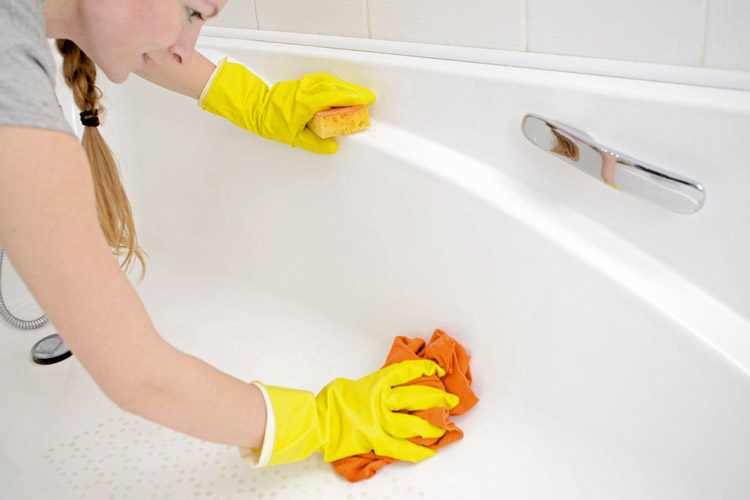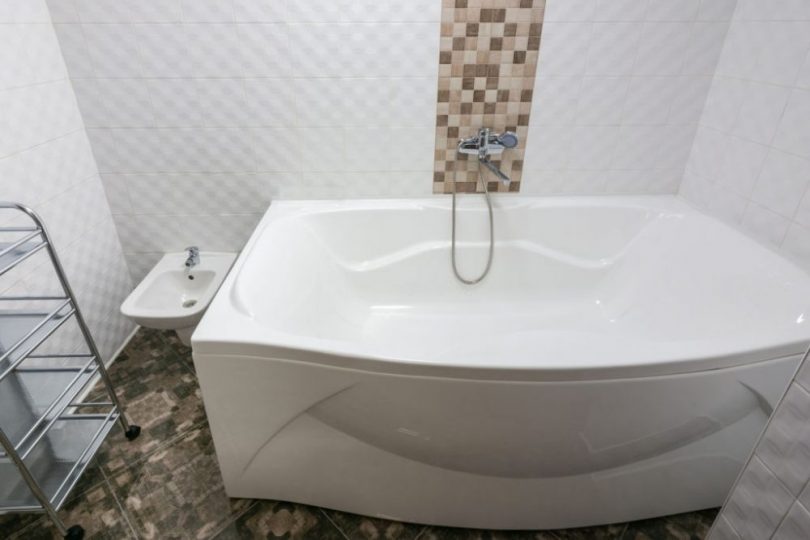With frequent use, stubborn stains may appear on the surface of your tub. Acrylic tubs, even the top-class ones, are especially difficult to clean because their delicate surface can be easily damaged. So, too harsh or too abrasive cleaning products aren’t an option in these cases.
There are many cleaning products on the market that can be applied on acrylic surfaces without risk of damage. However, not all of these products are really effective. For that reason, there’s a high chance of getting bad results when trying a certain cleaning product for the first time.
If you’re tired of scrubbing your acrylic tub to remove stubborn stains without satisfactory results, we’re here to help. Today, you’ll learn the best ways to clean your acrylic tub with household and store-bought cleaner. Let’s get started right away.
How to Clean an Acrylic Tub Easily?

1. Using Homemade Cleaners
With vinegar
White vinegar is a powerful disinfectant and stain remover. Also, it’s safe for acrylic surfaces. The natural acidity of white vinegar helps soften the gunk to be easily removed with soap and water.
To clean an acrylic bathtub, fill it first with hot water. Then, add a couple cups of white vinegar and wait 10-15 minutes. Finally, drain the tub and use a cloth soaked in soapy water to remove the stains.
With baking soda
The effervescent effect of baking soda helps whiten heavily stained surfaces and eliminate pathogens. For that reason, this recipe is ideal for white acrylic tubs. To apply it, fill a spray bottle with warm water. Then, add two teaspoons of baking soda and mix well.
Spray the surface with the mixture and wait at least 5 minutes. For a superior disinfecting effect, add a couple teaspoons of borax. This formula is especially effective for removing soap scum, mold and mildew.
You can also sprinkle the tub with baking soda and then scrub the surface with a damp sponge. When the water and baking soda mix together, the resulting abrasive paste will help remove the stubborn stains without scratching the surface.
To remove the accumulated gunk at the edges and difficult corners of your tub, soak an old toothbrush in warm water. Then apply baking soda to the bristles and scrub the surface.
With lemon juice
Citric acid is the main active ingredient in lemon juice. Like white vinegar, citric acid is very effective to soften stubborn stains. If the combined action of vinegar and baking soda isn’t enough to remove the gunk, rub a half lemon on the surface. Repeat the process until the stain disappears completely.
Finally, rinse the surface with warm water to remove the lemon residue.
2. Using Commercial Cleaners
With liquid soap
A mild liquid detergent can do miracles on a stained acrylic tub. To apply it you just need to pour a little soap on a damp sponge. Then scrub the surface several times to remove the stains. After that, rinse the surface with plenty of water to remove the soap.
Common dishwasher soap or antibacterial soap are very effective for removing soap scum and pathogens that may grow on the surface.
With acrylic cleaner
If it’s been too long since you cleaned your acrylic tub the last time, those stains will probably take more than soap and water to disappear. You might need something more aggressive like an acrylic cleaner to get the job done.
Before applying it to your tub, carefully read the instructions. Some concentrated products should be diluted so as not to affect the surface. Verify that all components of the formula are safe for acrylic.
With spray cleaners
Spray cleaners are usually much more concentrated than regular liquid cleaners. In addition, they’re very easy to apply and help you save water. You just need to spray the product directly on the stain, wait a half minute and clean the surface with a dry cloth. Before applying, carefully read the product instructions.
The Dos and Don’ts
The dos
- As said before, acrylic tubs are very delicate unlike cast iron tubs and require special care. Not all cleaning products that you use to clean your tiles and ceramic surfaces can be applied directly on acrylic.
- If you’ve just purchased an acrylic tub and it’s your first time cleaning it, you should follow the manufacturer’s suggestions. In the user manual or the official website of the product you can find a list of all the recommended cleaners and the chemicals that you can’t use.
- All biodegradable cleaners are usually safe for acrylic tubs. So, any of the homemade recipes on this guide will work perfectly well with any kind of tub.
The don’ts
- It isn’t recommended to use too harsh chemicals like acetone and other similar solvents to remove stubborn stains. Although some manufacturers recommend it, chlorine is also on the list of chemicals that you should avoid.
- Abrasive products like wire brushes and hard bristle brushes are also not allowed. Things like this leave ugly scratches on the surface where pathogens can grow.
Tips to Extend Your Tub’s Lifespan
- Make a deep clean in those difficult corners of your tub at least once a week.
- Don’t smoke while using your tub. The generated smoke can stain the surface permanently.
- Before trying any new cleaning product on your tub, check out the manufacturer’s recommendations in the user manual or the official website of the product.
- Use microfiber cloths and soft sponges to scrub and dry the surface.
Conclusion
As you can see, you don’t need to be a genius to learn how to clean an acrylic tub the proper way. The secret to success is choosing correctly all the cleaners and cleaning tools. Don’t try new cleaning products without first checking if its components are really safe for acrylic. The results may be irreversible after using harsh chemicals.
To not make mistakes, stick to the plan and carefully follow all the useful tips on this guide. That way, the cleaning process will be much less traumatic and your acrylic tub will last longer with all its benefits.
FAQs
Q. 1: Can I use bleach on acrylic tub?
Ans. It all depends on the manufacturer’s recommendations. If the user manual doesn’t prohibit bleach, then use it. Otherwise, better opt for mild cleaners.
Q. 2: Can I use white vinegar on acrylic tub?
Ans. Yes. White vinegar can be applied on acrylic without risk of damaging the surface.
Q. 3: Do acrylic tubs crack easily?
Ans. No. Acrylic is a non-porous material. This means that water won’t accumulate in the pores and cause that cracking commonly seen on fiberglass tubs.
Q. 4: Can I use Soft Scrub on acrylic tub?
Ans. No. Soft Scrub cleaners contain sodium hydroxide and other harsh chemicals that can damage the acrylic surface.
Q. 5: How to make a dull acrylic bathtub shine?
Ans. The best way of making a dull acrylic bathtub shine again is by scrubbing the surface with a cloth soaked in white vinegar. This technique helps remove all the gunk stuck to the surface and restore acrylic’s original shine.








Leave a Comment